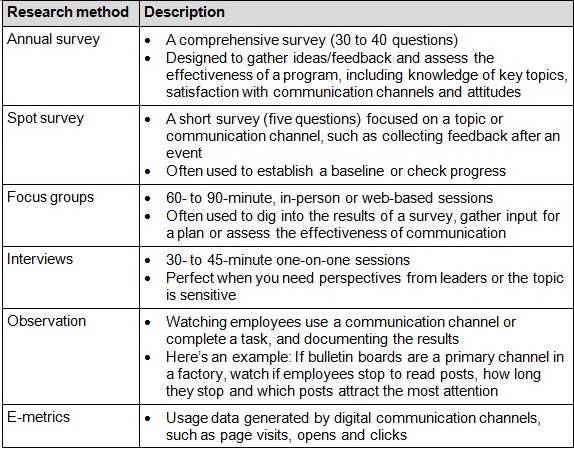
There are two dangerous assumptions you can make about employee communication:
#1: What you (or leaders) prefer about communication will appeal to all employees.
#2: Just because you sent a message, employees received it, understood it, bought into it and acted on it.
Many communication professionals bypass measurement because they believe it’s too time-consuming, too expensive and too mathematical. The good news? Measurement doesn’t have to be difficult.
Over the years, our clients have asked great questions about measurement. And when I gathered my favorites, I realized they’re a quick way to learn about measurement.
Ready to take employee communication measurement to the next level? Check out these advanced Frequently Asked Questions about measurement.
Measurement basics
What is measurement?
In employee communication, measurement is the process of evaluating the effectiveness of specific tactics or an entire program. Key attributes that are often measured include:
· Participation: Do employees use communication channels? Do they ask questions during town halls?
· Satisfaction: Do employees value communication?
· Knowledge: Do employees understand key topics?
· Attitudes: Do employees trust senior leaders? Do they believe in the direction of the organization?
· Behaviors: Have employees taken a required action or done something differently?
I’m new to measurement. What are the basics I should know?
As a foundation, there are two types of high-level data:
· Quantitative: numbers-focused data; for example, survey data or e-metrics generated by digital channels (such as opens and clicks)
· Qualitative: data that captures a point of view and characteristics; for example, an open discussion with employees asking them, “How could HR communication be improved?”
Here’s a quick overview of research methods that are appropriate for employee communication and when to use them:

Focus groups
I’ve never moderated a focus group. Do you have tips?
Moderating a focus group requires that you keep many plates in the air: stay on track with questions, encourage participation, decide when to ask follow-up questions — all while watching the clock.
Before conducting your first focus group, conduct a pilot session. And ask a colleague to observe and provide feedback. The more you practice, the better you’ll be able to juggle all those plates. To learn more, read Chapter 8/Moderating focus groups in How to conduct employee focus groups.
How many focus groups should I conduct?
Three. Wouldn’t it be great if the answer was just that simple? Unlike surveys, focus groups don’t have a formula to calculate the number of sessions you need to get a valid sample. But, after conducting many qualitative studies, I’ve noticed a reliable pattern that I call The Rule of Three.
Here’s the phenomenon: After three focus groups, key ideas start to repeat. So three has become my magic number, but I often adjust based on three (see a theme?) factors:
1. Objectives. Increase/decrease the number of focus groups based on the complexity and scope of your topic.
2. Audience. Adjust based on the colleagues or teams you need to influence with the data.
3. Speed. Fine-tune based on how quickly you need to use the results.
Surveys
How many open-ended questions should I include in a survey?
With an open-ended question, you invite the respondent to provide detail and perspective (rather than a simple yes/no or agree/disagree). For most surveys, two open-ended questions are sufficient. More than two and I find respondents repeat their answers — even though the questions are different. If your gut (or your boss) says more than two open-ended questions are required, then it’s time conduct a focus group.
What percentage of employees need to complete a survey in order to have an accurate assessment?
When it comes to surveys, there is a formula used to calculate a statistically valid sample. For example, with a population of 10,000, you need 964 responses.
Calculating your required sample size is straightforward thanks to the web. Search “sample size calculator” and you’ll find several calculators. When you use a calculator, target a confidence level of 95% and a margin of error of +3. Check out this blog post to learn more: How to determine the number of employees to survey.
How do I write the best survey questions?
The secret to writing better survey questions is being specific. Vague terms, rambling sentences and leading phrases are your enemy. Using the word “and” is the perfect example of not being concise: “Emails from HR and IT are timely.” If the respondent feels differently about the two sources, then he/she will be stuck. The solution is simple: create two questions. Before drafting questions for your next survey, take this quick on-demand workshop.
Resources to learn more
Want to learn more about employee communication measurement? Here are three resources to help you get started:
· How to measure employee communication
· Use deep insights to create breakthrough employee communication
· How to conduct employee focus groups
Originally published on Medium.com




